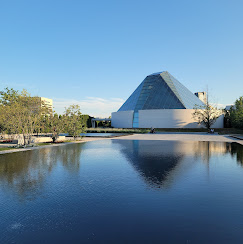New exhibition at the Aga Khan Museum shines a light on two decades of contemporary Islamic art 2025-10-10
At the Aga Khan Museum in Toronto, an exhibition celebrating the past 20 years of Islamic art features works that brim with inspiration from ancient traditions while remaining inseparable from the contemporary context in which they were made.
Filtered through modern perspectives, the show’s spectacular calligraphy, ornamentation, painting and poetry depict artistic tradition as an evolving form of contemporary expression, says Ulrike Al‑Khamis, the museum’s director and CEO, who also co-curated the exhibition.
“Muslim artists continue to interpret their artistic culture on their own terms,” Al-Khamis explains.
This raises the question of whether today’s artists, working in centuries-old traditions, can be celebrated as contemporary artists creating at the top of their game, she says.
“From a Western viewpoint, their works may not be considered contemporary art but from a different perspective,” they are ground-breaking, even avant-garde, she says.
From Abu Dhabi to Toronto
As the Sun Appears from Beyond: Twenty Years of the Al Burda Award debuted at the Louvre Abu Dhabi last year. A collaboration between the Aga Khan Museum and the United Arab Emirates Ministry of Culture, the exhibition features more than 60 artworks from the 355-piece Al Burda Award collection, which is regarded as encompassing the world’s most outstanding contemporary Islamic art.
The selected artworks intermingle with historical masterpieces from the Aga Khan Museum’s permanent collection, offering an opportunity to engage with the “creative spirit” of the Muslim world today, says Al-Khamis.
Upon entering the exhibition, visitors encounter the glow of Tawaf (2021), by Iraqi Canadian Dhia Al-Jazaeri. “It’s a phenomenal artwork that from far away looks like the sun,” says Al-Khamis, until closer inspection reveals golden calligraphic expressions referencing divine revelations.
Another breathtakingly skillful calligraphy piece, created in 2006 by UAE artist Maitha Al Shamsi, features bold, geometric script. Its ancient-verse title, He does not speak from his own desire, it is only a revelation revealed, “alludes to messengers of God,” says Al-Khamis, adding it also reflects the artist’s own spiritual guidance in creating the unconventional work.
One of the most experimental pieces is Ammar Al Attar’s engaging 2019 work, Milad, which documents the ritual celebrating the Prophet Mohammed’s birthday through a combination of visuals and devotional audio recordings.
With a final stop comprising a multilingual poetry listening station, the exhibition offers a meditative and multisensory journey – regardless of one’s beliefs, says Al-Khamis.
“I really want people, whatever their backgrounds, to feel immersed in beauty. I want the show to take us into a totally different domain where beauty and spirituality, whatever that means to you, are allowed to breathe.”
Light as a unifying theme
As the Sun Appears from Beyond was co-curated by Fatma Al Mahmoud, Sara bin Safwan, and Shaikha Al Zaabi, in collaboration with Al-Khamis and her team at the Aga Khan Museum. The young Emirati curators are the first recipients of a new Al Burda grant, which supports international curation projects.
Their journey began in July 2024, when they travelled to Toronto for a museum residency and developed the exhibition around the theme of light.
Creating a show “that would work both in Abu Dhabi and in Canada, where audiences are very different, was an experiment in intercultural dialogue and understanding,” says Al-Khamis.
The universal concept of light, she explains, unites traditional and contemporary artworks, and prompts reflection on how, in the arts of the Muslim world, this divine light really is carried by the artist, as well as exuded by the artworks.
“For me, [this] gives this exhibition soul,” she adds, admitting the idea is “difficult to put into words. You literally have to feel it.”
- 805 reads
 Ismaili.NET - Heritage F.I.E.L.D.
Ismaili.NET - Heritage F.I.E.L.D.